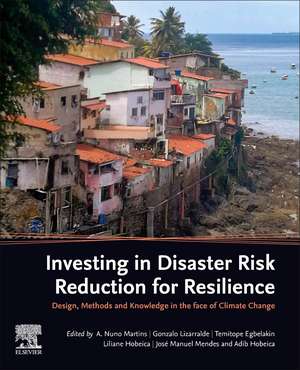Investing in Disaster Risk Reduction for Resilience: Design, Methods and Knowledge in the face of Climate Change
Editat de A. Nuno Martins, Gonzalo Lizarralde, Temitope Egbelakin, Liliane Hobeica, Jose Manuel Mendes, Adib Hobeicaen Limba Engleză Paperback – 17 mar 2022
In this book, prominent scholars and practitioners examine the successes and failures of the Sendai Framework. Their case studies show that, despite its good intentions, the Framework achieves very little. The main reason is that, while avoiding a political engagement, it fails to deal with disasters’ root causes and guide the difficult path of effective implementation. The authors bring a fresh look to international policy and design practices, highlighting cross-disciplinary research avenues, and ideas and methods for low-income communities, cities and heritage sites in Portugal, Haiti, the United States, the Philippines, New Zealand, Sri Lanka, Nigeria, among other countries.Global action requires collaboration between heterogeneous stakeholders, but also the recognition of inequalities, power imbalances, and social and environmental injustices.
- Analyzes outcomes and drawbacks of implementing the third priority of the Sendai Framework for Disaster Risk Reduction
- Presents real-life attempts to increase risk resilience and climate-change adaptation, both before and after disasters
- Addresses design as a means to build resilience in community and heritage interventions
- Calls for embracing the complexities and dynamic character of DRR and climate-change knowledge, investment, and communication
Preț: 563.12 lei
Preț vechi: 735.03 lei
-23% Nou
Puncte Express: 845
Preț estimativ în valută:
107.77€ • 112.37$ • 89.56£
107.77€ • 112.37$ • 89.56£
Carte tipărită la comandă
Livrare economică 13-27 martie
Preluare comenzi: 021 569.72.76
Specificații
ISBN-13: 9780128186398
ISBN-10: 0128186399
Pagini: 320
Ilustrații: 150 illustrations (75 in full color)
Dimensiuni: 191 x 235 x 25 mm
Greutate: 0.55 kg
Editura: ELSEVIER SCIENCE
ISBN-10: 0128186399
Pagini: 320
Ilustrații: 150 illustrations (75 in full color)
Dimensiuni: 191 x 235 x 25 mm
Greutate: 0.55 kg
Editura: ELSEVIER SCIENCE
Public țintă
Academics in disaster management, policymakers, architects, planners, NGO collaborators, humanitarian-aid workers, and risk practitioners in generalCuprins
Part A Investing in design for disaster risk reduction
1. Investing in community participation for disaster recovery
2. Investing in the social places of heritage towns
3. Investing in contingency in a heritage site
Part B Investing in new methods for resilience
4. Physical services index for flooding hazards
5. Resilience planning in antagonistic communities
6. Systems thinking toward climate resilience
7. Assessing urban resilience to cope with climate change
Part C Building knowledge on disaster risk reduction investment
8. Incentives for retrofitting heritage buildings in New Zealand
9. Dissatisfaction after postdisaster resettlement
10. The media coverage of climate change in Portugal
11. Investing in flood adaptation in Jakarta, Indonesia
1. Investing in community participation for disaster recovery
2. Investing in the social places of heritage towns
3. Investing in contingency in a heritage site
Part B Investing in new methods for resilience
4. Physical services index for flooding hazards
5. Resilience planning in antagonistic communities
6. Systems thinking toward climate resilience
7. Assessing urban resilience to cope with climate change
Part C Building knowledge on disaster risk reduction investment
8. Incentives for retrofitting heritage buildings in New Zealand
9. Dissatisfaction after postdisaster resettlement
10. The media coverage of climate change in Portugal
11. Investing in flood adaptation in Jakarta, Indonesia
